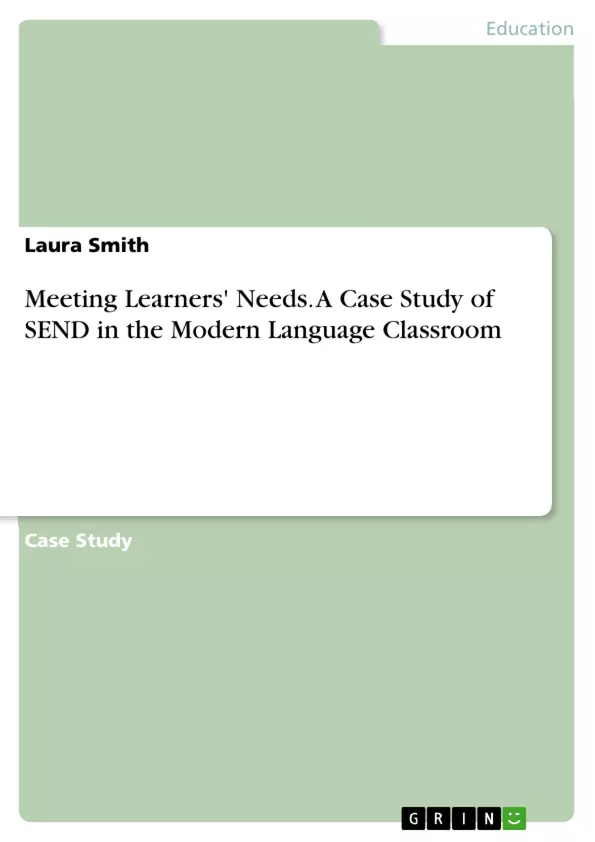All teachers face the challenge of making sure every pupil has the same access to education by adapting their teaching to suit different needs, known as inclusion. Kyriacou defines inclusive teaching as organising teaching and learning to "cater for pupils with a broad range of abilities and needs". Gedge refers specifically to pupils with a special educational need or disability (SEND) when considering inclusion and, although the focus of this study is SEND, it is important to note that inclusion refers to all pupils. As Holmes said: "no learner is the same as any other". Inclusion is not the same as differentiation, which refers to the methods employed by a teacher to make the learning accessible to all (Kyriacou, 2014), although this term is still significant in relation to making teaching inclusive.
This study aimed to find out how inclusion works in practice. I focused on Modern Language (ML) teaching and carried out a case study of two Year nine pupils with Asperger’s Syndrome, a condition within the wider range of Autistic Spectrum Disorder (ASD), in an 11-19 mixed comprehensive. I looked at how changes to teaching and the classroom environment affected their learning over six one-hour lessons. I will consider views from a range of literature on the subject and use several methods of data collection to analyse the results and conclude whether the teaching had an impact. I will then explore these findings in relation to my future practice.
Inhaltsverzeichnis (Table of Contents)
- Abstract
- 1. Literature Review
- 2. Research Design
- 2.1 Pre-Implementation
- 2.2 Implementation
- 3. Data Analysis
- Conclusion
Zielsetzung und Themenschwerpunkte (Objectives and Key Themes)
This study aimed to investigate how inclusive teaching practices can be implemented to meet the needs of students with Asperger's Syndrome in Modern Language (ML) lessons. The study focused on a case study of two Year nine students with Asperger's Syndrome in a mixed comprehensive school, examining how changes to teaching and the classroom environment impacted their learning over six one-hour lessons. The research explored relevant literature on inclusive teaching, Asperger's Syndrome, and the impact of language learning on students with special educational needs.
- Inclusive teaching practices for students with Asperger's Syndrome
- The impact of teaching methods and classroom environment on students with Asperger's Syndrome
- The importance of consistency and clarity in instructions for students with Asperger's Syndrome
- The role of visual aids and written instructions in supporting students with Asperger's Syndrome
- The importance of understanding individual needs and adapting teaching methods accordingly
Zusammenfassung der Kapitel (Chapter Summaries)
- Abstract: This section introduces the study's focus on inclusive teaching practices in Modern Languages, particularly for students with Asperger's Syndrome. It defines key terms like inclusive teaching and SEND, highlighting the importance of tailoring instruction to meet individual needs.
- 1. Literature Review: This chapter explores existing research on inclusive teaching, specifically focusing on students with special educational needs, particularly Asperger's Syndrome. It examines different perspectives on labeling students and the importance of considering individual needs. The chapter also discusses various teaching methodologies that can be adapted for students with Asperger's Syndrome, emphasizing the need for consistency, clarity, and visual support.
- 2. Research Design: This chapter outlines the methodology employed in the study, which is a case study. It discusses the rationale for using a non-probability sample and purposive sampling. The chapter also addresses the ethical considerations of the research, including informed consent and confidentiality.
- 2.1 Pre-Implementation: This section delves into the data collection process prior to the implementation of the chosen strategies. It explains the use of individual education plans (IEPs) as documentary evidence to understand the specific needs of the students and inform teaching practices.
Schlüsselwörter (Keywords)
Inclusive teaching, special educational needs (SEND), Asperger's Syndrome, Autistic Spectrum Disorder (ASD), Modern Language (ML) teaching, case study, purposive sampling, individual education plan (IEP), consistency, clarity, visual support, individual needs.
- Arbeit zitieren
- Laura Smith (Autor:in), 2017, Meeting Learners' Needs. A Case Study of SEND in the Modern Language Classroom, München, GRIN Verlag, https://www.grin.com/document/374103



